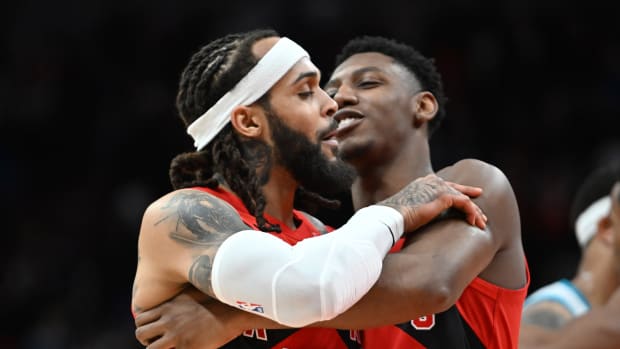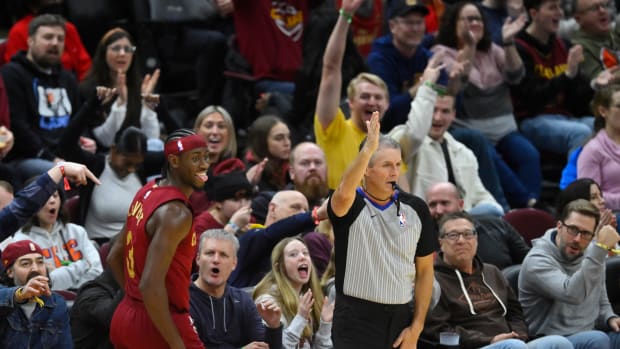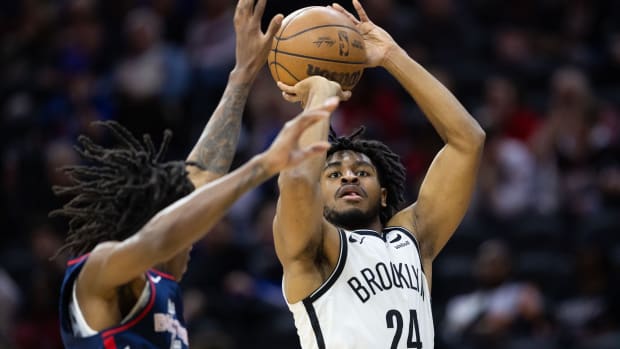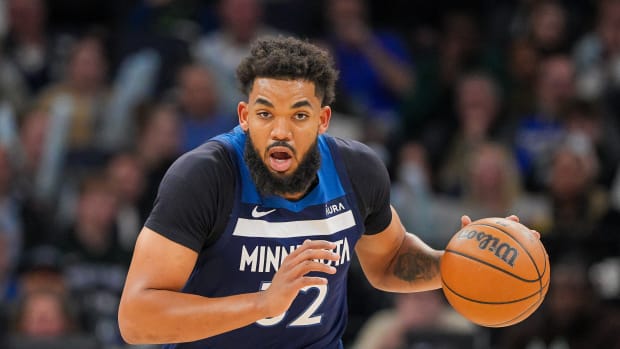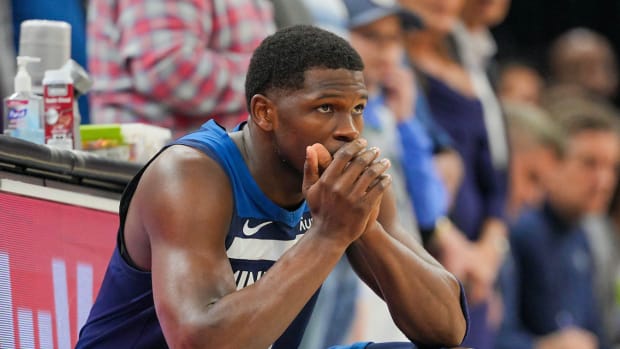Inside the Making of 'The Last Dance'
Moving up the June premiere of The Last Dance, ESPN’s sweatily anticipated, years-in-the-making treatise on Michael Jordan and the ‘98 Bulls, for which clamoring reached a fever pitch at the onset of social distancing measures, was not as simple as pressing a “play” button a couple months early.
“Clearly we had to accelerate the workflow and the output of the work,” Jason Hehir, the director of the documentary, told Sports Illustrated. Even with Hehir and his team ramping up their already Herculean effort to finish editing the 10-hour behemoth, they were still working on the final episode of the series as recently as the second week of April—with the documentary scheduled to debut on April 19.
“When the world sees the premiere, we still won’t be done with the backend of the series,” Hehir told SI. “We’ll be working right up until the final day.”
What’s done is already incredibly compelling. SI was given the first eight episodes of The Last Dance, and particularly for basketball fans thirsty for intrigue amid the shutdown of all sports, the documentary certainly delivers on the hype. The Bulls, of course, were more than a successful basketball team. They were a collection of egos and characters, led by arguably the most popular athlete ever, a combination creating an international phenomenon. The doc captures it all, with a wide breadth of interviews and a willing subject in Jordan.
MJ was more than just a participant, he was one of many who helped oversee the project. According to Hehir, Jordan “never once” told him to remove something that could be considered unflattering. The result is the fullest portrayal of Jordan and the Bulls yet, with input from both friends and foes.
Earlier this month, Hehir took a break from finishing up The Last Dance to discuss undertaking this project, interviewing MJ, and a lot more.
(This interview has been edited and condensed for clarity.)
Rohan Nadkarni: With so much footage, both from the NBA and your own interviews, how different was the process of this documentary compared to ones you worked on before, if at all?
Jason Hehir: It’s a completely different process than any doc that I’ve ever done, both from a logistical standpoint and story standpoint. Logistically, the net that we had to cast was exponentially wider on this doc than its been on previous ones. The longest project that I’ve done has been two television hours, and this is 10. We started with a list of 250 people that I wanted to interview, we pared that down to 106, which is the amount that we actually shot. The amount of editors, the amount of edit rooms that we had, the amount of footage that we had to go through, it was much more challenging.
From a storytelling standpoint, I can’t think of a doc that I’ve done that wasn’t linear in nature. You look at a story like the ‘85 Bears, it’s pretty easy to tell that story with how Mike Ditka got there and then the ‘85 season. You don’t do a lot of jumping around in time. Our biggest challenge with this series was chronology, figuring out a way to tell everyone’s story, to give every story justice, to tell it in an honest and responsible way, but not to confuse the viewer because we have to jump around so many times.
RN: What did it mean to you personally that you were trusted with making this documentary?
JH: It was certainly an honor that everyone involved trusted me. This was the indelible team of my childhood in any sport. They were a global cultural phenomenon. I was there when Michael scored 63 in the [Boston] Garden in 1986, and I was there with my dad. I was saying to my dad, if you went back to that day and said someone in this section here in 30 years is going to be chosen to do a 10-hour documentary on the Bulls and Michael Jordan, I would have thought I won the lottery. Then if you said someone from the Boston Garden would have been chosen on that day, I would have thought. “How am I this lucky?” And you can go on and on and on. To be tasked with this, it’s an enormous privilege and an enormous responsibility. That was not lost on any of us.
RN: That was my next question. How much pressure did you feel while making this?
JH: A lot, I still do. There’s a lot of partners on this project. A lot of cooks in the kitchen. And everyone has different tastes, different opinions on what should be included and what shouldn’t be included. And these are people who’ve become trusted partners over the past few years. This is almost 10% of my life at this point I’ve given to this project. I want to do right by everybody but I also want to do right by my vision that I saw at the outset. There’s an enormous pressure that you feel from all sides, to satisfy them but also maintain your own artistic integrity.
RN: The NBA has been sitting on this footage from that Bulls season for years, Why do you think Michael Jordan and the Bulls were willing to tell this story now?
JH: I can’t speak for him, and for Jump Inc. and for the NBA as to why this happened now. I can say the landscape now, given the prevalence of long-form documentaries and documentary series and how popular those have become, I can say that now is a perfect time to tell a story like this. Because it does deserve to be told in several parts. It’s an enormous story, and I think you’d be selling the Bulls short and I think you’d be selling Michael Jordan short if you tried to tell this story in 75 or 90 minutes.
RN: I still get nervous before certain interviews. Did you feel that way at all while doing the interviews for this? Or were you completely locked into the process?
JH: Absolutely, there’s certainly butterflies and anxiety. We interviewed Michael three times, and the first one, I didn’t know what to expect. I had met him a few times and we had enough of a rapport to sit down and have a discussion, and I think that he trusted me, but I didn’t know if he was going to leave a half hour in, if he wouldn’t like a question, I didn’t know if he planned on staying for an hour or two hours. I felt an obligation to him to tell his story the right way, but also keep him engaged and structure the interview so he stayed stimulated and focused.
And then you’re sitting across from someone who is a living icon. This is someone who was up on a poster on my walls. There’s a lifetime of questions I’ve wanted to ask him as a basketball fan, and now you’re sitting in front of that person and you’re allowed to ask the questions. I told my brothers the first time I met him it was like meeting the real Santa Claus. I couldn’t believe that this person actually exists. To his credit, that feeling dissipates really quickly when you’re talking to him, because he’s so welcoming.
RN: I think a lot of people assumed the documentary could easily be moved up from June. What challenges did you face in changing the release date?
JH: We were already in fifth gear, the challenging part came when the shelter-in-place order came down in New York. We all had to go back to our apartments. So much of the product is borne of these collaborative moments. When you’re separated like that, you can’t just walk into someone’s room and say, “Show me that again. Or show me that with a different music cue.” Those are little microdecisions that are made thousands of times a day because you’re having these interactions with trusted partners. When you subtract from the equation, and you’re trying to connect over Zoom, email, or FaceTime, that makes it very difficult. It’s very isolating creatively. It’s definitely more of a challenge, but we have an incredible team, and everyone was built for this.
RN: When you’re making a documentary like this one, how do you balance your artistic vision versus what some people remember as what the truth is?
JH: It’s a good question, because a lot of people are going to come into this with an agenda. There are things though that I discovered while making this, and that’s really the joy in making it, is when you do two years of research, go to an interview, and find out something you never knew. That’s a pretty good indicator that a lot of people don’t know it.
For example, when Isiah Thomas talks about the Celtics walking off the floor against [the Pistons] when [Boston] beat them in the conference finals. I’m a Celtics fan, and I remember that shot of Kevin McHale shaking Isiah’s hand. And I asked him in the interview, “You know, it seems hypocritical because Kevin McHale came up to you and shook your hand, and you didn’t do the same for the Bulls.” You can see, we included it in the doc, he shakes his head and says. “No, that’s not how it was.” Even I come into it expecting to tell certain stories, and then when you sit down with these people, especially with some distance from it, they’re more likely to tell the truth, unvarnished.






























